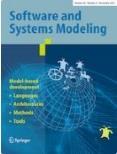
Software and Systems Modeling
軟件和系統(tǒng)建模
- 期刊周期:Quarterly
- 研究方向:工程技術(shù)
- 影響因子:2.66
- 通訊地址:SPRINGER HEIDELBERG, TIERGARTENSTRASSE 17, HEIDELBERG, GERMANY, D-69121
- 官網(wǎng):http://sosym.org/
- 投稿地址:https://mc.manuscriptcentral.com/sosym
- 審稿速度:>12周,或約稿
中文簡(jiǎn)介
軟件與系統(tǒng)建模(Sosym)是一本國際季刊(英文版),主要關(guān)注與軟件和系統(tǒng)建模語言和技術(shù)的開發(fā)和應(yīng)用有關(guān)的理論和實(shí)踐問題。該雜志的目的是出版高質(zhì)量的作品,進(jìn)一步了解建模語言和技術(shù)的理論基礎(chǔ),對(duì)建模經(jīng)驗(yàn)進(jìn)行嚴(yán)格分析,并引入可擴(kuò)展的建模技術(shù)和過程,以促進(jìn)軟件的嚴(yán)格、高效或經(jīng)濟(jì)開發(fā)。該雜志特別強(qiáng)調(diào)建模語言和技術(shù)的理論基礎(chǔ),以及對(duì)“現(xiàn)實(shí)世界”建模經(jīng)驗(yàn)的嚴(yán)格分析。理論工作和基于經(jīng)驗(yàn)深入分析的工作之間的平衡為研究人員提供了見解,可以為未來更好的建模語言和技術(shù)的研究提供信息,并為建模從業(yè)者提供了對(duì)建模語言和技術(shù)的更深入理解,從而使其能夠更有效地應(yīng)用。該雜志的目標(biāo)是研究人員、實(shí)踐者和學(xué)生,他們對(duì)高質(zhì)量的建模研究和嚴(yán)格分析的建模經(jīng)驗(yàn)產(chǎn)生的結(jié)果具有既得利益。我們邀請(qǐng)作者提交論文,討論和分析有關(guān)軟件和系統(tǒng)建模語言、技術(shù)、工具、實(shí)踐和其他方面的研究挑戰(zhàn)和經(jīng)驗(yàn)。以下是一些特別感興趣的主題領(lǐng)域,但該雜志發(fā)表了廣泛的軟件和系統(tǒng)建模問題:領(lǐng)域特定的模型和建模標(biāo)準(zhǔn)基于模型的測(cè)試技術(shù)基于模型的仿真技術(shù)建模語言(如UML)的形式語法和語義嚴(yán)格的基于模型的分析模型組成、細(xì)化和轉(zhuǎn)換軟件語言工程科學(xué)與工程建模語言語言適應(yīng)與寫作元建模技術(shù)測(cè)量模型和語言的質(zhì)量模型工程的本體論方法從模型生成測(cè)試和代碼工件模型綜合方法論模型開發(fā)工具環(huán)境網(wǎng)絡(luò)物理系統(tǒng)建模數(shù)據(jù)密集型建模從數(shù)據(jù)推導(dǎo)顯式模型案例研究和經(jīng)驗(yàn)報(bào)告,具有重要的建模經(jīng)驗(yàn)教訓(xùn)建模語言與技術(shù)的比較分析建模實(shí)踐的科學(xué)評(píng)估有關(guān)更多信息,請(qǐng)?jiān)L問www.sosym.org,其中包含最近的社論,以及有關(guān)不同論文類別(如定期調(diào)查/概述和特殊主題)提交過程的信息。
英文簡(jiǎn)介
Software and Systems Modeling (SoSyM) is a quarterly international journal (published in English) that focuses on theoretical and practical issues pertaining to the development and application of software and system modeling languages and techniques. The aim of the journal is to publish high-quality works that further understanding of the theoretical underpinnings of modeling languages and techniques, present rigorous analyses of modeling experiences, and introduce scalable modeling techniques and processes that facilitate rigorous, efficient or economical development of software.The journal is unique in its emphasis on theoretical foundations of modeling languages and techniques, and on rigorous analyses of "real-world" modeling experiences. The balance of theoretical works and works based on in-depth analyses of experiences offers insights to researchers that can inform future investigations into better modeling languages and techniques, and provides modeling practitioners with a deeper understanding of modeling languages and techniques that can lead to more effective application.The journal targets researchers, practitioners and students who have a vested interest in results generated by high-quality modeling research and by rigorously analyzed modeling experiences. We invite authors to submit papers that discuss and analyze research challenges and experiences pertaining to software and system modeling languages, techniques, tools, practices and other facets. The following are some of the topic areas that are of special interest, but the journal publishes on a wide range of software and systems modeling concerns:Domain-specific models and modeling standardsModel-based testing techniquesModel-based simulation techniquesFormal syntax and semantics of modeling languages such as the UMLRigorous model-based analysisModel composition, refinement and transformationSoftware Language EngineeringModeling Languages in Science and EngineeringLanguage Adaptation and CompositionMetamodeling techniquesMeasuring quality of models and languagesOntological approaches to model engineeringGenerating test and code artifacts from modelsModel synthesisMethodologyModel development tool environmentsModeling Cyberphysical SystemsData intensive modelingDerivation of explicit models from dataCase studies and experience reports with significant modeling lessons learnedComparative analyses of modeling languages and techniquesScientific assessment of modeling practicesMore information can be found at www.sosym.org, which contains recent editorials, as well as information about the submission process for different paper categories (such as regular survey/overview, and special themes).
近年期刊自引率趨勢(shì)圖
JCR分區(qū)
| JCR分區(qū)等級(jí) | JCR所屬學(xué)科 | 分區(qū) | 影響因子 |
| Q3 | COMPUTER SCIENCE, SOFTWARE ENGINEERING | Q3 | 2.211 |
近年期刊影響因子趨勢(shì)圖
CiteScore數(shù)值
| CiteScore | SJR | SNIP | 學(xué)科類別 | 分區(qū) | 排名 | 百分位 |
| 6.00 | 0.833 | 1.744 | 大類:Mathematics 小類:Modeling and Simulation | Q1 | 38 / 303 |
87% |
| 大類:Mathematics 小類:Software | Q2 | 120 / 398 |
69% |
相關(guān)工程技術(shù)SCI期刊推薦
- SemimonthlyADVANCED MATERIALS
- Journal of Materials Chemistry A
- MonthlyADVANCED FUNCTIONAL MATERIALS
- SemimonthlyAPPLIED CATALYSIS B-ENVIRONMENTAL
- SemimonthlyJOURNAL OF HAZARDOUS MATERIALS
- SemimonthlyJOURNAL OF ALLOYS AND COMPOUNDS
- MonthlyBiotechnology for Biofuels
- Materials Science & Engineering C-Materials for Biological Applications
- MonthlySmall
- MonthlyJOURNAL OF THE ELECTROCHEMICAL SOCIETY
SCI期刊欄目
SCI期刊 工程技術(shù) 物理 生物 化學(xué) 醫(yī)學(xué) 農(nóng)林科學(xué) 數(shù)學(xué) 地學(xué)天文 地學(xué) 環(huán)境科學(xué)與生態(tài)學(xué) 綜合性期刊 管理科學(xué) 社會(huì)科學(xué)
期刊論文百科問答
- sci投稿中關(guān)于online常見的問題匯總
- 攝影藝術(shù)領(lǐng)域AHCI期刊推薦《Photography And Culture》
- Nature旗下多學(xué)科子刊Nature Communications
- 中小學(xué)教師值得了解,這些教育學(xué)期刊發(fā)論文容易被人大復(fù)印轉(zhuǎn)載
- 2025年寫管理學(xué)論文可以用的19個(gè)選題
- 測(cè)繪領(lǐng)域科技核心期刊選擇 輕松拿捏
- 及時(shí)開論文檢索證明很重要
- 中國水產(chǎn)科學(xué)期刊是核心期刊嗎
- 國際出書需要了解的問題解答
- 合著出書能否評(píng)職稱?
